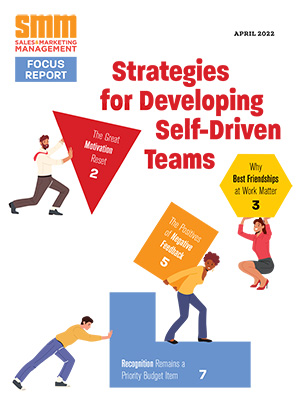In less than a year, Generative AI has shifted from an interesting concept in the sales organization to full adoption.
However, adoption comes with challenges. While sales and enablement leaders acknowledge the technology’s power, they remain unclear about how to integrate AI’s capabilities with those of the sales team, especially when AI can now absorb some of the work that has traditionally sat with sellers. Leaders need a plan for adopting GenAI in a way that goes beyond productivity gains and complements the unique skills that only humans can deliver.
Gartner forecasts that within two years, 95% of sellers’ research workflows will begin with AI, and that the median sales technology spending will exceed $10,000 per seller per year. Importantly, these projections don’t suggest that sellers are becoming obsolete. Instead, these figures indicate that the seller’s role will change and that their greatest strengths will be those that AI cannot easily replicate.
To understand these strengths, sales organizations must do two things: learn how generative AI disrupts seller workflows and identify the new behaviors AI demands from sellers.
Changing Seller Workflows
To fully benefit from AI’s capabilities, sales organizations must understand the use cases that represent both high business value and high feasibility. For example, use cases such as lead scoring, cross-selling and territory optimization are all valuable to the selling organization and feasible for AI to accomplish. Other, more complex tasks, such as needs discovery, shaping and guiding conversations, and relationship intelligence, also have value, but are difficult for AI to manage, and are therefore not feasible.
In the last year, we have seen five distinct use cases emerge. All of them balance value to the selling organization with ease of implementation.
Hyper-Personalization at Scale
GenAI enables sellers to create highly customized outreach content, including emails, LinkedIn messages and call scripts tailored to each individual’s needs down to a specific buyer’s role, industry, company goals and even recent news. Previously, sellers struggled to generate top-of-funnel opportunities because doing so required cutting through the noise and getting noticed. Sellers can now use AI to develop a hyper-personalized approach to outreach that piques the prospect’s curiosity, reframes their thinking and drives action.
AI-Assisted Account Intelligence
AI can synthesize massive datasets — such as CRM data, public filings, social media and more — to surface prospects that fit within a business’ ideal customer profiles. This approach goes beyond simply reviewing static firmographic data, such as revenue and organizational structure, to analyze digital signals indicating that a company is considering solutions similar to those the seller offers.
Revenue Intelligence for Deal Coaching
Sellers can utilize GenAI to analyze buying signals and trigger relevant data in both live conversations and offline communication. With this approach, sellers can identify deal risks, such as single-threading, lack of buyer engagement and competitive risk. When AI presents these risks in data visualizations, sellers and managers can quickly identify important and actionable deal information.
Behavioral Analytics to Diagnose Alignment to Methodology
AI not only reveals details about buyers, it also offers crucial information about sellers. Specifically, AI can assess how well a seller is demonstrating the specific, measurable and observable behaviors that drive wins. The technology can analyze how well sellers demonstrate critical skills in front of customers and prospects. Selling organizations can listen to sales conversations to assess how effectively sellers apply the skills and practices aligned with the organization’s methodology. This real-time data clearly shows how well a sales transformation is progressing and provides insights into calibrating the enablement strategy.
Suggested ChatGPT Prompts:
- What are the main points of the following 10K filing?
- What are the key takeaways from the following call transcript?
- What are the main business plans cited in the following annual report?
Redefining Seller Behaviors in the Age of AI
Given the emergence of AI in seller workflows, where can a seller deliver unique value?
Sellers can appeal to the customer’s emotional state in a way that AI cannot. This ability is essential because buyers often rely on both logic and emotion when making purchasing decisions. AI is equipped to serve the customer’s need for logic by creating a rational business case, preparing an agenda and talking points, and using research to demonstrate an understanding of the buyer’s business. Sellers, in contrast, are uniquely suited to address the emotional aspects of making a purchase.
Doing so requires focus on four key areas:
- Emotional Intelligence
Sellers have just a few valuable opportunities to engage with buyers. Making the most of those moments requires critical seller skills that are the keys to regulating and demonstrating a high degree of emotional intelligence.
- Situational Fluency
Situational fluency balances different approaches based on a dynamic assessment of the situation. The seller’s job is to guide the buyer, so they make the best decision for themselves and their company. This approach involves a series of gentle pushes, pulls and nudges that guide buyers toward action. • High-Stakes Conversations High-stakes conversations
present elevated levels of risk, but also offer outsized rewards. These are moments when the best sellers have a chance to differentiate themselves and make an impact. Examples of high-stakes conversations include positioning a price increase or managing adversarial negotiations.
- Judgment and Critical Thinking
The customer’s problems and concerns are often complex. Critical thinking involves creative, context-based problem-solving grounded in lived professional experiences. Judgment involves assessing stakeholders, the solution’s fit, negotiation strategies and competitive positioning.
The combination of sound judgment and incisive critical thinking enables a seller to transition from being a reactive order-taker to a strategic consultant who can navigate large deals through organizational complexity to a successful close.
Suggested ChatGPT Prompts
- What is the general tone of the following email text?
- How could this CTA be more conversational CTA than what is written here?
- What are some ways to convert the following text to plain speak?




